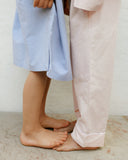Wash & Care
Once you have acquired your lovely new Geismars products, it's important to know how to best take care of them. Even though the quality is top-notch, there are several things you need to do to ensure longevity. We guide you through the best possible maintenance of our products, and if you have any questions, feel free to contact us.
General Care for All Geismars Textiles
- All of our products should be washed before use to enhance absorbency, ensure loop retention, and to allow them to shrink to the correct size.
- Always wash white, light, and strong colors separately to preserve the original color. Use the correct detergent without optical brighteners.
- Correct detergent dosage is essential to avoid excess soap residue. Never add too much, as leftovers can make fabrics stiff. Over time, too much detergent can make fabrics brittle.
- Fabric softeners can soften textiles, but they reduce fiber absorbency and encourage pilling. Additionally, fabric softeners are harmful to the environment. You can use a little clear vinegar as an alternative, as it helps with lime buildup and can help preserve colors.
- Follow the manufacturer's recommendations for loading the washing machine.
- Remember to clean your washing machine monthly, as residue from beauty products and other chemicals can affect the washing results.
- Avoid soaking textiles with larger stains. Instead, use glycerin or a stain remover.
- It’s important that bedding with bamboo buttons is hung up immediately after washing and not left wet in the washing machine or laundry basket. Bamboo buttons, like other wood, can transfer onto the bedding when left wet.
- Be cautious with cosmetic products around textiles. Specifically, be aware of creams, oils, makeup, hair products, perfumes, and other similar products that may contain fat, oil, silicone, color, or perfume. These chemicals can cause staining, discoloration, and fading of textiles. When such products come into contact with textiles, they can cause permanent discolorations when washed with detergents.
Aesthetic Sustainability
As with all types of textiles, washing, drying, and excessive use affect durability. Although most people have a favorite set of bedding, we recommend rotating between several sets. Sleeping for 6-8 hours every night puts significant pressure on the material. By rotating between sets, you will automatically extend the lifespan of each piece. We recommend having at least 3 sets of bedding in rotation – one in the closet, one in the wash, and one in use – ideally more.
It might sound like a lot with 3 sets, but if you compare it to a cotton shirt or a pair of canvas shoes, you can imagine how rotating them can help prolong their durability. Unlike a fresh shirt every day, bedding is used for more than one night at a time.
Cotton
Household Tip:
An old household tip suggests soaking towels and other cotton textiles before use. This was relevant when there were no washing machines, and oils and dirt needed to be dissolved before they could be washed out. Today, we are lucky enough that modern washing machines can handle this task on their own. At Geismars, we still recommend washing your cotton textiles before use for several reasons:
- Cotton shrinks, and the measurements we provide are after shrinkage. Bedding will fit properly only after washing. Expect cotton to shrink 2-3% in length after washing.
- Cotton naturally contains some 'cotton wax' that needs to be washed out for the cotton to absorb optimally. There may also be residues from spinning oil in the weaving process that needs to be washed out.
- The loops in terry cloth are very loose before washing. They bind after washing and fully bind after 3-4 washes. (If a loop unravels, simply trim it to the same length as the others).
- Products have passed through several hands before arriving at your home. It’s much more pleasant to crawl into "freshly washed bedding."
Washing, Drying & Ironing
- Cotton can be washed at high temperatures. However, colored fabrics should be washed at a maximum of 60°C using a detergent designed for colored textiles to preserve the original color. Particularly dark fabrics should be washed with a detergent specifically designed for dark colors.
- In areas with very hard water, you can use one cup of clear vinegar in the washing machine to make the fabric softer.
- Light tumble drying results in a softer and airier texture. However, tumble drying also causes more wear on textiles.
- All our cotton products can be ironed, except for terry cloth. Plain weave and satin weave bedding look best when rolled or ironed, but it’s not a requirement.
- Our stone-washed bedding has gone through a softening process and achieved a natural light crinkle, so it does not require ironing. However, you can steam it with a steamer if desired.
- Terry cloth consists of loops that may be very loose before washing. They bind after washing and fully bind after 3-4 washes. (If a loop unravels, trim it to the same length as the others).
- If you experience loose threads on terry cloth, simply cut them off.
Wool
- Geismars recommends that all lambswool and cashmere throws be maintained solely by dry cleaning to preserve optimal durability and softness.
Linen
- Never wash our Linen by Geismars textiles at temperatures over 60°C and always use a gentle program to preserve the fibers' resilience.
- Colored linen products can be washed up to 40°C, while white linen products can be washed up to 60°C.
- It’s important that linen bedding is hung up immediately after washing and not left wet in the washing machine or laundry basket. Bamboo buttons, like other wood, can transfer onto the bedding if left wet together.
- Light tumble drying results in a softer and airier texture, but tumble drying also wears down the fabrics.
- Never use fabric softener when washing linen, as it affects absorbency.
- You can use a cup of clear vinegar instead, which helps with lime buildup, softens the fabric, and helps preserve colors.
- Since Geismars linen textiles are stone-washed, they don’t need ironing, as they have the perfect natural crinkle. However, you can steam them with a steamer.
Down & Feathers
Air Daily:
It’s a misconception that down products must be washed frequently. In fact, washing down products unnecessarily can wear them down.
At Geismars, we recommend taking good care of your duvet and pillow by giving them a good shake every day. This helps the down to release the heat and moisture it has absorbed overnight. Heat and moisture cause the down to clump together if not aired properly.
Although a bedspread can be lovely to look at, avoid covering your duvet and pillow too quickly. If your duvet and pillow are still warm, they won’t be able to release moisture if covered. Therefore, we recommend shaking out your duvet and folding it at the foot of the bed, so the mattress can air out during the day. Bedspreads can be used if the bed is left undisturbed for longer periods to prevent dust.
You can occasionally tumble dry your pillow to ensure the down is completely dry.
Air your down products outside once a week, especially when you change the bedding.
Washing
If you care for your down products as recommended above, you can wash them only if you've been very sick or have sweated more than usual.
Geismars duck and goose down duvets and pillows can be washed at 60°C. Use enzyme-free detergent – the same kind used for wool and silk. Always tumble dry completely to ensure a fluffy result and preserve the quality. It’s helpful to add tennis balls when drying, as they help fluff the down.
Our eiderdown duvets should be professionally dry cleaned.
For further questions, please call +45 33 33 08 30 or email info@geismars.dk. We’ll be happy to assist you. If we don’t know the answer, we’ll contact the Danish Technological Institute, who regularly helps us with testing and answers.














